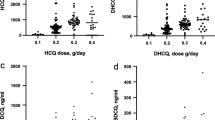Abstract
Glutathione S-transferase (GST) enzymes play an important role in drug metabolism. GST is a multigene family of enzymes involved in the detoxification and in a few instances activation of a wide variety of chemicals. Detoxification features make it plausible to search for GST polymorphism in patients with drug eruption. The GSTM (mu), GSTT (theta) and GSTP (pi) have been shown to be polymorphically distributed. The GSTT1, GSTM1 and GSTP1 gene polymorphism were detected using real-time PCR. GSTM1 and GSTT1 null genotypes were found to be associated with an increased risk of drug eruption (OR 2.27, 95% CI 1.20–5.21; OR 2.48, 95% CI 1.12–6.39, respectively). No relationship was observed between the null combination of the GSTM1 and GSTT1 genotype polymorphisms and drug eruption risk (OR 2.65, 95% CI 0.62–11.25). Our results show that GSTP1 polymorphism is not a significant contributor to drug eruption risk. The GSTM1 and GSTT1 gene polymorphisms seem to be associated with the development of drug eruption. Further studies may shed additional light on the role of GSTM1, GSTT1 and GSTP1 in drug eruption.
Similar content being viewed by others
References
Kaplan AP (1984) Drug-induced skin disease. J Allergy Clin Immunol 74:573–579
Weck AL (1991) Pharmacologic and Immunochemical mechanisms of drug hypersensitivity. Immunol Allergy Clin North Am 11:461–473
Van Arsdel PP (1991) Classification and risk factors for drug allergy. Immunol Allergy Clin North Am 11:475–491
Roujeau JC, Huynh TN, Bracq C, Guillaume JC, Revuz J, Touraine R (1987) Genetic susceptibility to toxic epidermal necrolysis. Arch Dermatol 123:1171–1173
Batchelor JR, Welsh KI, Tinoco RM, Dollery CT, Hughes GR, Bernstein R, Ryan P, Naish PF, Aber GM, Bing RF, Russell GI (1980) Hydralazine-induced systemic lupus erythematosus: influence of HLA-DR and sex on susceptibility. Lancet 1:1107–1109
Wooley PH, Griffin J, Panayi GS, Batchelor JR, Welsh KI, Gibson TJ (1980) HLA-DR antigens and toxic reactions to sodium auromalate and D-penicillamine in patients with rheumatoid arthritis. N Engl J Med 303:300–302
Clarck DW (1985) Genetically determined variability in acetylation and oxidation. Therapeutic implications. Drugs 29:342–375
Shear NH, Spielberg SP (1988) Anticonvulsant hypersensitivity syndrome: in vitro assessment of risk. J Clin Invest 82:1826–1832
Evans WE, Relling MV (1999) Pharmacogenomics: translating functional genomics into rational therapeutics. Science 286:487–491
Sheehan D, Meade G, Foley VM, Dowd CA (2001) Structure, function and evolution of glutathione transferases: implications for classification of non-mammalian members of an ancient enzyme superfamily. Biochem J 360:1–16
Eaton DL, Bammler TK (1999) Concise review of the glutathione S- transferases and their significance to toxicology. Toxicol Sci 49:156–164
Board PG, Baker RT, Chelvanayagam G, Jermiin LS (1997) Zeta, a novel class of glutathione transferases in a range of species from plants to humans. Biochem J 328:929–935
Moscow JA, Fairchild CR, Madden MJ, Ransom DT, Wieand HS, O’Brien EE, Poplack DG, Cossman J, Myers CE, Cowan KH (1989) Expression of anionic glutathione S-transferase and P-glycoprotein genes in human tissues and tumors. Cancer Res 49:1422–1428
Watson MA, Stewart RK, Smith GB, Massey TE, Bell DA (1998) Human glutathione S-transferase P1 polymorphisms: relationship to lung tissue enzyme activity and population frequency distribution. Carcinogenesis 19:275–280
London SJ, Yuan JM, Chung FL, Gao YT, Coetzee GA, Ross RK (2000) Isothiocyanates, glutathione S-transferase M1 and T1 polymorphisms, and lung-cancer risk: a prospective study of men in Shanghai, China. Lancet 356:724–729
Ko Y, Koch B, Harth V, Schinidis A, Thier R, Vetter H, Bolt HM, Brüning T (2000) Rapid analysis of GSTM1, GSTT1 and GSTP1 polymorphisms using real-time polymerase chain reaction. Pharmacogenetics 10:1–4
Chan SH, Tan T (1989) HLA and allopurinol drug eruption. Dermatologica 179:32–33
Park BK, Pirmohamed M, Kitteringham NR (1995) The role of cytochrome P450 enzymes in hepatic and extrahepatic human drug toxicity. Pharmacol Ther 68:385–424
Chosidow O, Bourgault L, Roujeau JC (1994) Drug rashes. What are the targets of cell-mediated cytotoxicity? Arch Dermatol 130:627–629
Rieder MJ, Uetrecht J, Shear NH, Spielberg SP (1988) Synthesis and in vitro toxicity of hydroxylamine metabolites of sulphonamides. J Pharmacol Exp Ther 244:724–728
Meekins CV, Sullivan TJ, Gruchalla RS (1994) Immunochemical analysis of sulfonamide drug allergy: identification of sulfamethoxazole-substituted human serum proteins. J Allergy Clin Immunol 94:1017–1024
Kerb R, Brockmöller J, Reum T, Roots I (1997) Deficiency of glutathione S-transferase T1 and M1 as heritable factors of increased cutaneous UV sensitivity. J Invest Dermatol 108:562–565
Schnuch A, Westphal GA, Muller MM, Schulz TG, Geier J, Brasch J, Merk HF, Kawakubo Y, Richter G, Koch P, Fuchs T, Gutgesell T, Reich K, Gebhardt M, Becker D, Grabbe J, Szliska C, Aberer W, Hallier E (1998) Genotype and phenotype of N-acetyltransferase 2 (NAT2) polymorphism in patients with contact allergy. Contact Dermatitis 38:209–211
Ollier W, Davies E, Snowden N, Alldersea J, Fryer A, Jones P, Strange R (1996) Association of homozygosity for glutathione-S-transferase GSTM1 null alleles with the Ro+/La- autoantibody profile in patients with systemic lupus erythematosus. Arthritis Rheum 39:1763–1764
Harries LW, Stubbins MJ, Forman D, Howard GC, Wolf CR (1997) Identification of genetic polymorphisms at the glutathione S-transferase Pi locus and association with susceptibility to bladder, testicular and prostate cancer. Carcinogenesis 18:641–644
Ryberg D, Skaug V, Hewer A, Phillips DH, Harries LW, Wolf CR, Ogreid D, Ulvik A, Vu P, Haugen A (1997) Genotypes of glutathione transferase M1 and P1 and their significance for lung DNA adduct levels and cancer risk. Carcinogenesis 18:1285–1289
Sundberg K, Johansson AS, Stenberg G, Widersten M, Seidel A, Mannervik B, Jernstrom B (1998) Differences in the catalytic efficiencies of allelic variants of glutathione transferase Pl-1 towards carcinogenic diol epoxides of polycyclic aromatic hydrocarbons. Carcinogenesis 19:433–436
Author information
Authors and Affiliations
Rights and permissions
About this article
Cite this article
Ateş, N.A., Tursen, U., Tamer, L. et al. Glutathione S-transferase polymorphisms in patients with drug eruption. Arch Dermatol Res 295, 429–433 (2004). https://doi.org/10.1007/s00403-003-0446-z
Received:
Revised:
Accepted:
Published:
Issue Date:
DOI: https://doi.org/10.1007/s00403-003-0446-z




